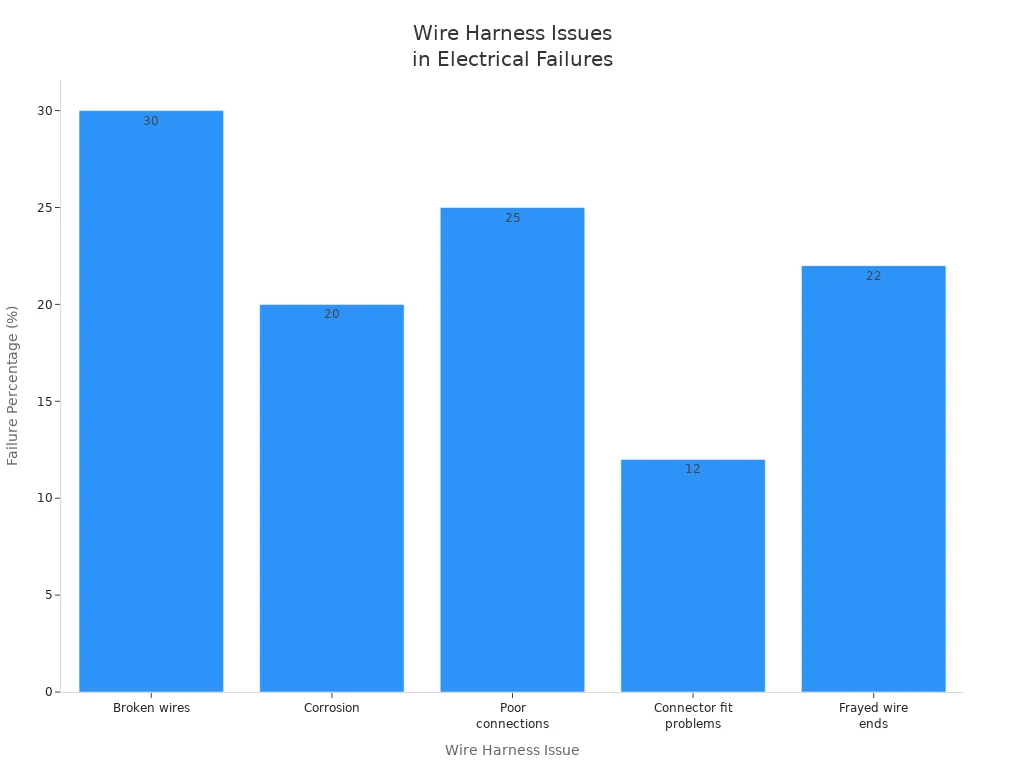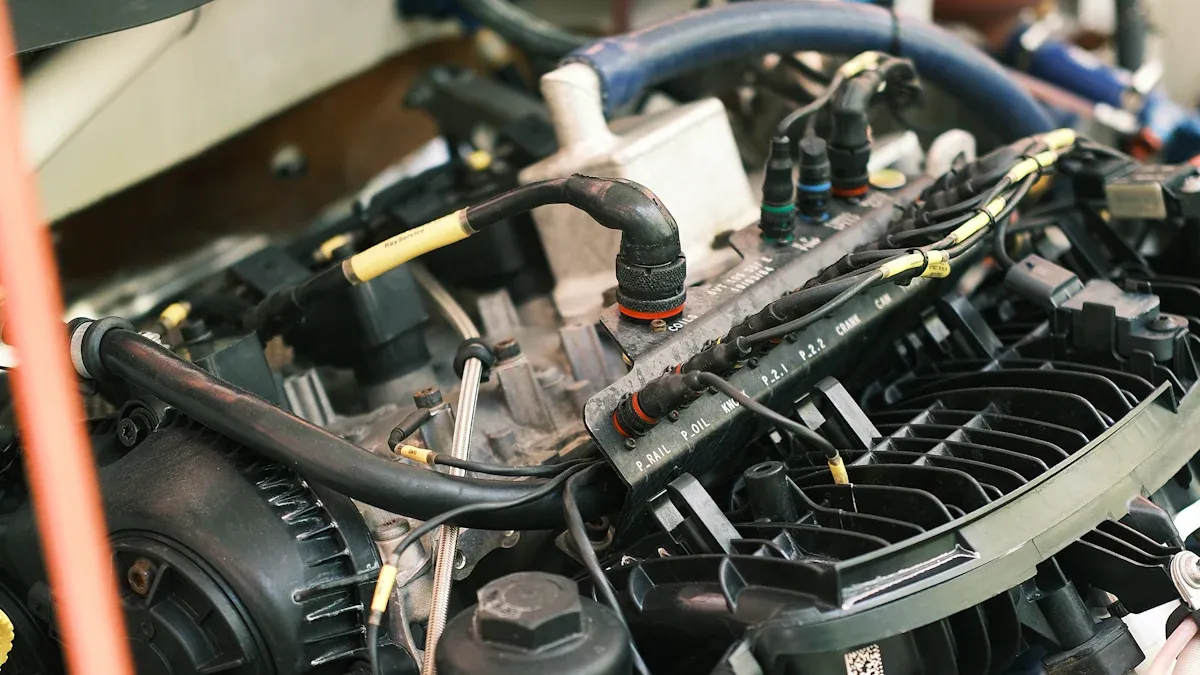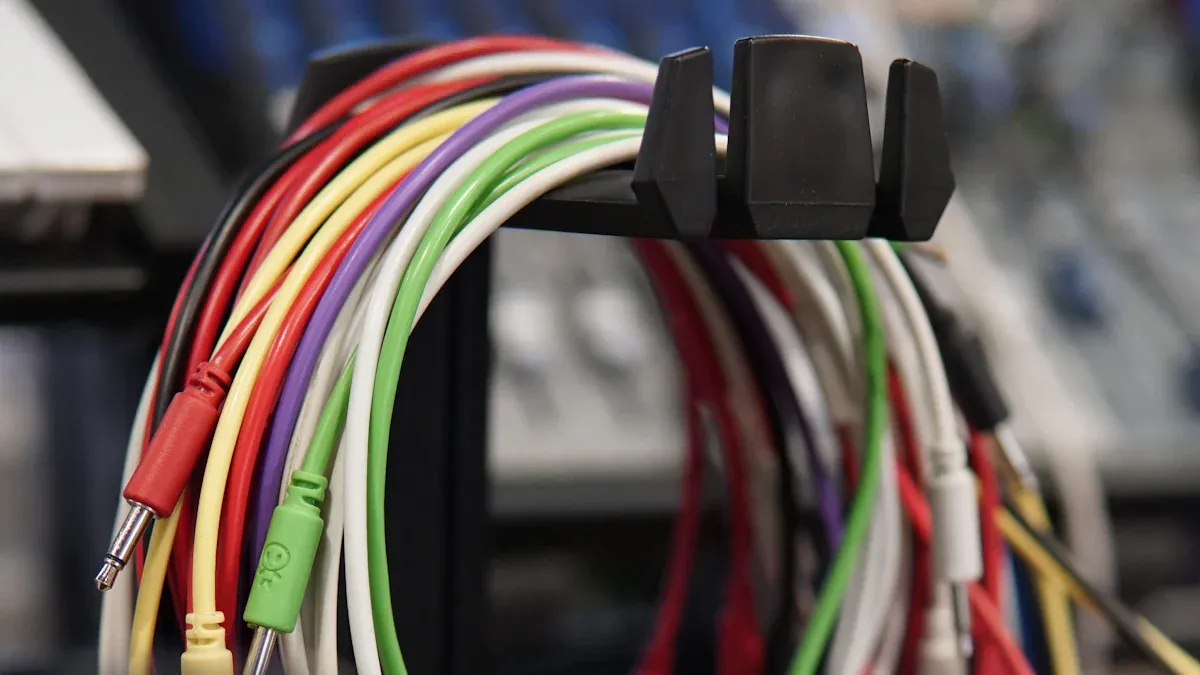An auto wire harness is the main network in your car. It links all the electrical parts together. Automotive engineers call it the main body of the car’s circuit. It has wires, connectors, and tape that protects the wires. These wires are put together in a neat way. They make up the backbone of your car’s electrical system. The harness connects power to different car parts. It follows the car’s design and layout.
Most car wire harnesses use soft copper wires with many strands. These wires are wrapped together to connect parts well. The harness works like your body’s nervous system. It sends power and signals to every part that needs them. Soft copper wires make the harness bend easily and stay strong. This is important for modern cars with many features. The wire harness is needed for your car’s electrical systems to work safely and well.
The auto wire harness carries power and signals between car parts. It is more than just a bunch of wires. It has connectors, terminals, and covers that protect the wires. These parts help send power and information where it is needed.
The wire harness keeps everything neat and in order. It routes wires so they do not get tangled or damaged. The harness also protects wires from interference and harm. This helps your car work safely and well.
Knowing about the parts of an auto wiring harness shows why good quality is important for your car’s safety and how well it works. Each part helps your car’s electrical systems work right. At Fuzhou Fuqiang Precision Co., Ltd., we use strong materials and careful steps to make wire harnesses you can trust for any car.
Wires and Cables
Every wire harness has many wires and cables inside. These move power and signals to all parts of your car. The most used materials are:
Copper wire: This type lets electricity flow well and bends easily, so it is used most often.
Aluminum wire: It is lighter than copper and helps electric cars weigh less.
Tinned copper wire: This is copper with a tin coat, which stops rust and works well in tough places.
The cover around the wire is very important too. You will see covers made from PVC, XLPE, or rubber. These keep wires safe from heat, chemicals, and damage. Some wires have shields to stop signal problems, so your car’s electronics work well. At Fuqiang, we also make braided copper wire and special harnesses for different needs.
Material | Key Properties | Typical Use |
Copper | High conductivity, flexible, corrosion-resistant | Most common for flexibility and reliability |
Aluminum | Lightweight, cost-effective | Used in large vehicles and EVs |
Tinned Copper | Enhanced corrosion resistance | Harsh environments, engine compartments |
Connectors and Terminals
Connectors and terminals join wires to each part or sensor in your car. Good connectors keep the harness steady and safe. The metal on terminals—like gold, silver, or tin—stops rust and helps electricity flow better. This keeps your car’s parts working together, even when things get rough.
Blade, pin, round, and rectangle connectors are used for different jobs.
Terminals with special metal do not rust or wear out fast, so you fix them less.
Connectors must fit the wire size and power level to stay tight.
You get strong and safe connections because we check quality and use good tools. Our team uses special crimping and tests to make sure every connection is solid.
Insulation and Protection
Insulation keeps wires safe from heat, water, and shaking. There are many kinds of covers and shields in a wire harness:
Insulation/Protection Type | Key Features | Application/Benefit |
Corrugated Tubing | Bends easily and keeps wires safe | For tricky wire paths |
Heat Shrinkable Tubing | Blocks dust, water, and rust | Stops water and rust from getting in |
Fiberglass Sleeving | Handles high heat | Protects engines and motors |
Expandable Braided Sleeving | Bends and lets heat out | Keeps wires neat and cool |
Extruded PVC Tubing | Cheap and gives basic safety | Used for simple wire covers |
You may also see braided sleeves, tape, and tubes that add more safety. At Fuqiang, we use strong rubber and foam to keep wires safe, even in hard places. We follow strict rules like ISO and IATF16949 to make sure every harness is safe and high quality.
Note: New ideas like lighter materials, smaller connectors, and green covers help wire harnesses work in electric cars and new car tech.
When you pick a wire harness from Fuzhou Fuqiang Precision Co., Ltd., you get strong materials, smart building, and a promise of safety and long life. All these parts work together to keep your car safe and running well.
Automotive Wiring Harness Types
There are different wire harnesses in cars. Each harness does a special job. These harnesses keep wires neat and safe. You can find harnesses for the engine, chassis, dashboard, and electric vehicles. Each type helps your car work in its own way.
Engine Harness
The engine harness controls wires for the engine and sensors. It connects to the engine controller and sensors for oil, air, and temperature.
It keeps engine signals away from other systems.
You can fix engine wires easily because it joins the chassis harness at places like the fuse box.
This setup lets you repair engine wires without touching other parts.
Tip: Keeping engine and chassis harnesses apart makes fixing problems faster and saves time.
Chassis Harness
The chassis harness handles bigger car systems. It works for gauges, lights, inside power, and body electronics.
It has main, front, and rear harnesses for things like instruments, music, and air fans.
Putting the harness on the chassis keeps wires safe from shaking and rubbing.
Gauges and panels use the chassis harness and link to the engine harness when needed.
Harness Type | Main Functions | Design Benefit |
Engine Harness | Engine control, sensors | Modularity, easy maintenance |
Chassis Harness | Gauges, lighting, body electronics | Protection, broad coverage |
Dashboard Harness
The dashboard harness links all dashboard tools and entertainment systems. It connects audio, video, GPS, Bluetooth, and Wi-Fi.
This harness gives steady power and data for inside features.
It uses strong materials and smart building for long life.
The design makes adding and fixing parts easy.
You get smooth use of climate, music, and car controls.
Note: As dashboard tech gets better, harnesses change to move data faster and use new materials.
EV and Custom Harnesses
Electric cars need special wire harnesses. These harnesses have thick covers and shields for high voltage and to block interference.
EV harnesses use bendy cables and good connectors for small spaces and safety.
You can pick wire sizes, covers, and connectors to fit your car.
Custom harnesses let you choose everything, so your harness fits just right.
Customization Aspect | Description |
Wire Gauge & Length | Custom sizes for best results |
Shielding & Insulation | Stops interference and lasts longer |
Connector Options | Many types, including high-voltage connectors |
Flexibility | Soft cables for tight spots |
Fuqiang helps you with worldwide building, expert help, and trusted quality. You get strong harnesses for new energy and electric cars. Their team has lots of experience and always looks for new ideas.
Wire Harness Benefits and Issues
Safety and Reliability
Your car’s wire harness helps keep you safe. It makes sure your car works well every time you drive. Good wire harnesses help your car’s electrical parts run smoothly. Car makers follow strict safety rules like UL, SAE, ISO, and IEC. These rules make sure wire harnesses resist fire, handle voltage, and last long. They help stop electrical shorts, fires, and signal loss.
Smart design choices help protect your car from electrical problems. These include not bending wires too much, holding harnesses tight, and using strong materials. If you pick a good wire harness, your car breaks down less and you drive safer.
Tip: Test your wire harness often. Look at it and check insulation. This helps you find problems early.
Common Problems
Wire harnesses can have problems as your car gets older. You might see flickering lights or your engine stops. Sometimes your car is hard to start. These can mean wire harness trouble.
Here are some common problems and why they happen:
Common Problem | Description | Causes / Contributing Factors |
Mechanical Wear and Tear | The wire cover wears out from rubbing and shaking, especially near metal. | Metal touching wires, loose wires, or shaking can scrape wires. |
Water Ingress | Water gets in and hurts the wire harness. | Broken covers, bad seals, or old connectors let water in. |
Burnt or Ablated Wires | Wires burn or melt from too much heat or short circuits. | Too much power, bad connections, or wires that are too thin. |
Poor Contact in Connectors | Bad connections cause electrical problems. | Loose plugs, dirt, rust, or bent terminals can cause this. |
Wire Harness Fracture | Wires break from stress or getting old. | Too much bending, tight spaces, or old wires in tough places. |
You can stop many problems by checking your wire harness often and fixing things early.
Maintenance Tips
Taking care of your wire harness helps your car last longer. It also saves you money on repairs. Try these easy steps to keep your wire harness working well:
Check your wire harness every year. Look at connectors and places where wires touch other parts.
Use covers or sleeves to protect wires from heat, water, and rubbing.
Change broken wires for strong, rust-proof ones.
Clean connectors and make sure they fit tight for good power flow.
Do not add too many gadgets to one circuit.
Hold the wire harness in place with clips or ties so it does not move or wear out.
Ask a car expert to check your wire harness when you get your car serviced.
Note: Cleaning and securing connectors helps your wire harness last longer. It also keeps your car safe.
Choosing an Auto Wiring Harness
Selection Tips
Picking the right auto wire harness helps your car work well. It also helps you avoid electrical trouble. You should think about a few key things before you choose:
Think about where the harness will go. If your car gets hot, wet, or dirty, pick connectors that protect well.
Choose harnesses with strong locks and strain relief. These keep wires safe when your car moves.
Use plastic for light jobs. Use metal if you need something tough.
Make sure connectors have low resistance and good shielding. This keeps signals clear and stops interference.
Check that the harness fits your car’s wiring. Match wire sizes and connector types to handle heat and stress.
Decide if you want a custom or ready-made harness. Custom harnesses are best for special cars.
Work with a supplier who follows strict rules and checks quality.
Pick harnesses that let you add more circuits or power later.
You also need to check what your car needs for power. Figure out the current and voltage for each part. Pick wire sizes that can handle the load so wires do not get too hot. Shielded cables and twisted-pair wires help keep signals strong, especially in new cars.
Tip: Working with a company like Fuzhou Fuqiang Precision Co., Ltd. gives you better materials, certified work, and expert help. Their team helps you pick the best harness for your car.
Installation Advice
Installing your wire harness the right way keeps it safe and makes it last longer. Follow these steps for a good job:
Strip and organize the wires before you start.
Put wires into connectors tightly and use locks so they do not come loose.
Test every connection to make sure power and signals work.
Use sleeves and insulation to protect wires from heat, water, and damage.
Label wires so you can find them easily later.
Hold the harness in place with clips or ties so it does not move.
Check the harness often for rust, water, or loose wires.
Step | Why It Matters |
Wire Preparation | Stops shorts and makes strong connections |
Secure Insertion | Keeps wires from coming loose |
Testing | Makes sure everything works before you finish |
Protective Sleeves | Protects wires from tough conditions |
Labeling | Makes repairs and upgrades easier |
Harness Securing | Lowers wear and risk of damage |
Regular Inspection | Keeps your harness safe and working |
Getting help from experts makes installation easier and helps you avoid mistakes. Fuqiang gives you clear manuals, labeled wires, and technical help for fast and safe installation. Their service includes training, advice, and quick help if you have problems. You can feel safe knowing experts are there to help you.
Note: Picking a trusted supplier with good support and quality checks makes your harness safer, easier to install, and last longer.
Auto wire harnesses work like your car’s nervous system. They move power and signals to each part. This helps your car stay safe and run well. If you pick a harness with strong materials and the right certification, your car is safer from shorts and damage. Checking your harness often and installing it carefully can stop expensive repairs. If you are not sure what to do, ask an expert for help. Working with certified and smart suppliers like Fuzhou Fuqiang Precision Co., Ltd. helps you feel calm and keeps your car working for a long time.
FAQ
What does an auto wire harness do in your car?
An auto wire harness connects all the electrical parts in your car. It sends power and signals to lights, sensors, and controls. This helps every system work together safely and smoothly.
How can you tell if your wire harness has a problem?
You might see flickering lights, hear strange sounds, or notice that some features stop working. If your car has trouble starting or warning lights stay on, check the wire harness.
Can you replace a wire harness by yourself?
You can replace a simple wire harness if you have basic tools and follow instructions. For complex harnesses, ask a professional or contact Fuzhou Fuqiang Precision Co., Ltd. for support.
Why should you choose a certified wire harness supplier?
Certified suppliers use high-quality materials and follow strict standards. This gives you a safer, longer-lasting wire harness. You lower the risk of electrical problems in your car.
How often should you inspect your car’s wire harness?
Check your wire harness at least once a year. Look for signs of wear, rust, or loose connections. Regular checks help you catch problems early and keep your car safe.











